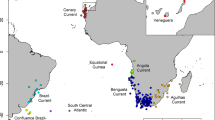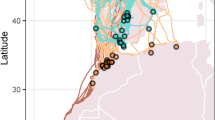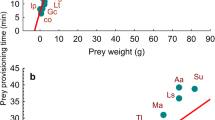Abstract
OPTIMAL foraging theory is based on the assumption that natural selection favours animals that forage most efficiently1–3. But such selection does not act directly on foraging efficiency, but rather indirectly by favouring animals that survive and reproduce most successfully. Studies that use optimal foraging models often assume that maximization of some behavioural currency, such as the animal's net rate of energy gain, maximizes the animal's fitness4, but rarely is an attempt made to test this assumption5–8. Most studies of the effects of foraging behaviour on fitness fail to control for the amount of energy gained by the foraging animals5–8, and lead to the obvious conclusion that animals that eat more reproduce more. Often the studies do not control for characters correlated with foraging behaviour6 or compare traits assumed to be correlated with fitness7,8. A better method would be to assign net rates of energy gain to randomly chosen individuals for their entire lifetimes in a controlled environment and measure fitness directly. Variation in the amount of energy consumed would be controlled by using individuals that employ a time-minimizing foraging strategy9 and would alter the time taken to satisfy their daily energy requirements, while obtaining the same absolute amount of energy. I have now manipulated the net rate of energy gain in four populations of the zebra finch Taeniopygia guttata, and show that fitness, as measured by population growth rate, is indeed positively and significantly correlated with the net rate of energy gain.
This is a preview of subscription content, access via your institution
Access options
Subscribe to this journal
Receive 51 print issues and online access
$199.00 per year
only $3.90 per issue
Buy this article
- Purchase on Springer Link
- Instant access to full article PDF
Prices may be subject to local taxes which are calculated during checkout
Similar content being viewed by others
References
Krebs, J. R. in Behavioural Ecology: An Evolutionary Approach (eds Krebs, J. R. & Davies, N. B.) 22–63 (Blackwell, Oxford, 1978).
Pyke, G. H. A. Rev Ecol. Syst. 15, 523–575 (1984).
Stephens, D. W. & Krebs, J. R. Foraging Theory (Princeton Univ. Press, Princeton, 1986).
Schoener, T. W. A. Rev. Ecol. Syst. 2, 396–404 (1971).
Wise, D. H. Oecologia 41, 289–300 (1979).
Fritz, R. S. & Morse, D. H. Oecologia 65, 194–200 (1985).
Ritchie, M. E. Evol. Ecology 2, 232–252 (1988).
Ritchie, M. E. Oecologia 82, 56–67 (1990).
Hixon, M. A. Am. Nat. 119, 569–599 (1982).
Benkman, C. W. Auk 107, 376–386 (1990).
Benkman, C. W. & Pulliam, H. R. Ecology 69, 1195–1199 (1988).
Sullivan, K. A. Anim. Behav. 39, 380–387 (1990).
Sokal, R. R. & Rohlf, F., Biometry (Freeman, San Francisco, 1981).
Miller, B. G., Kirkwood, J. K., Howard, K., Tuddenham, A. & Webster, A. J. F. Lab. Anim. 51, 313–317 (1981).
Hails, C. J. Condor 85, 61–65 (1983).
Caswell, H. Matrix Population Models (Sinauer, Sunderland, Massachusetts, 1989).
Cooper, W. S. J. theor. Biol. 107, 603–629 (1984).
Meyer, J. S., Ingersoll, C. G., McDonald, L. L. & Boyce, M. S. Ecology 67, 1156–1166 (1987).
Morrison, M. L., Ralph, C. J., Verner, J. & Jehl, J. R. Studies Avian Biol. 13, 1–515 (1990).
Author information
Authors and Affiliations
Rights and permissions
About this article
Cite this article
Lemon, W. Fitness consequences of foraging behaviour in the zebra finch. Nature 352, 153–155 (1991). https://doi.org/10.1038/352153a0
Received:
Accepted:
Issue Date:
DOI: https://doi.org/10.1038/352153a0
This article is cited by
-
Sex-specific foraging behaviour in a long-lived seabird
Marine Biology (2023)
-
Direct and correlated responses to artificial selection on foraging in Drosophila
Behavioral Ecology and Sociobiology (2023)
-
Darwin’s empirical claim and the janiform character of fitness proxies
Biology & Philosophy (2022)
-
Experimentally manipulated food availability affects offspring quality but not quantity in zebra finch meso-populations
Oecologia (2022)
-
Risk of predation: a critical force driving habitat quality perception and foraging behavior of granivorous birds in a Nigerian forest reserve
Avian Research (2019)
Comments
By submitting a comment you agree to abide by our Terms and Community Guidelines. If you find something abusive or that does not comply with our terms or guidelines please flag it as inappropriate.



